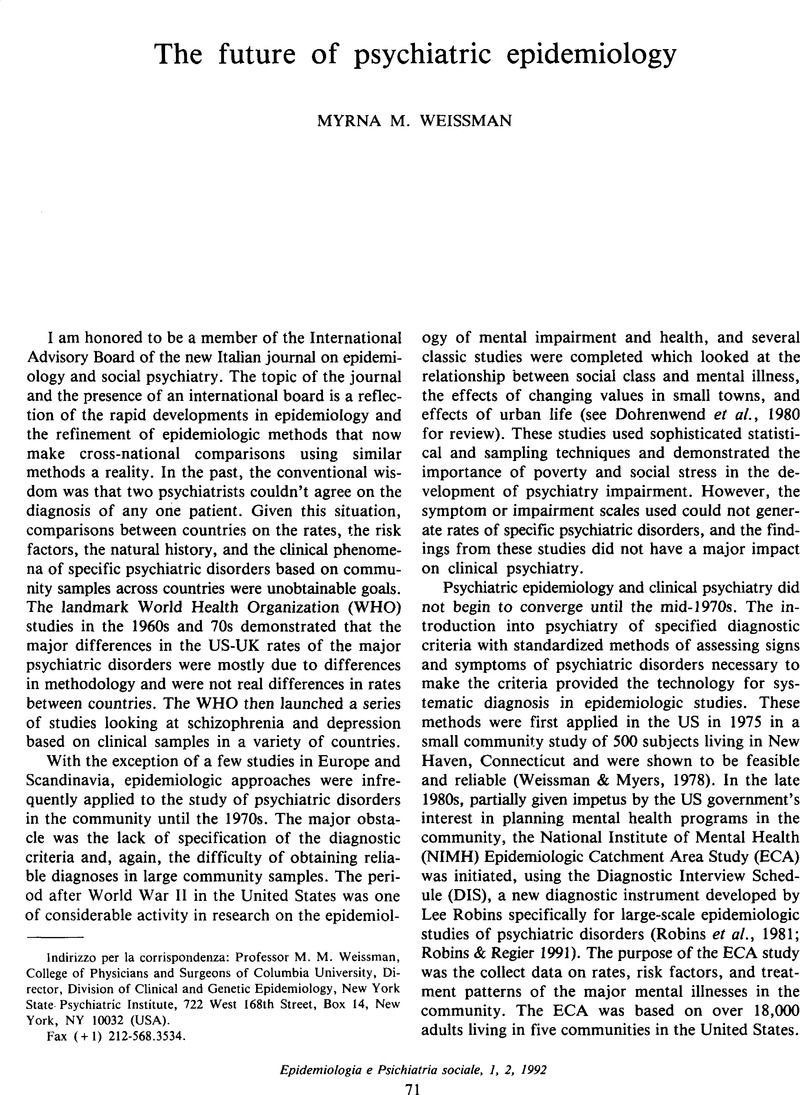No CrossRef data available.
Article contents
The future of psychiatric epidemiology
Published online by Cambridge University Press: 11 October 2011
Abstract
An abstract is not available for this content so a preview has been provided. As you have access to this content, a full PDF is available via the ‘Save PDF’ action button.

- Type
- Editoriali
- Information
- Copyright
- Copyright © Cambridge University Press 1992
References
REFERENCES
Bland, R. C., Orn, H. & Newman, S. C. (1988). Lifetime prevalence of psychiatric disorders in Edmonton. Ada Psychiatrica Scandinavica, 11, 24–32.Google Scholar
Canino, G. J., Bird, H. R., Shrout, P. E., Rubio-Stipec, M., Bravo, M., Martinez, R., Sesman, M. & Guevara, L. M. (1987). The prevalence of specific psychiatryc disorders in Puerto Rico. Archives of General Psychiatry 44, 727–735.CrossRefGoogle Scholar
Dohrenwend, B. P., Dohrenwend, B. S., Gould, M. S., Link, B., Neugebauer, R. & Wunsch-Hitzig, R. (1980). Mental Illness in the United States: Epidemiological Estimates. Praeger Publishers: New York.Google Scholar
Faravelli, C., Degl'Innocenti, G., Aiazzi, L., Incerpi, G. & Pallanti, S. (1990). Epidemiology of mood disorders: a community survey in Florence. Journal of Affective Disorders, 20, 135–141.CrossRefGoogle ScholarPubMed
Hwu, H. G., Yeh, E. K. & Chang, L. Y. (1989). Prevalence of psychiatric disorders in Taiwan defined by the Chinese Diagnostic Interview Schedule. Ada Psychiatrica Scandinavica 79, 136–147.Google Scholar
Joyce, P. R., Oakely-Brown, M. A., Wells, J. E., Bushnell, J. A. & Hornblow, A. R. (1990). Birth cohort trends in major depression: increasing rates and earlier onset in New Zeland. Journal of Affective Disorders, 18, 83–90.CrossRefGoogle Scholar
Karam, E. (1991). Presented at the ITSS, Washington, D.C., October 1991; Karama, E., Barakeh, M., Karam, A. N. & El-Khouri, N.Revue Médical Libanaise 3, 28.Google Scholar
Klerman, G. L. (1988). Overview of the cross-national collaborative panic study. Archives of General Psychiatry 45, 407, 412.CrossRefGoogle ScholarPubMed
Klerman, G. L. & Weissman, M. M. (1989). Increasing rates of depression. Journal of the American Medical Association 261, 2229–2235.CrossRefGoogle ScholarPubMed
Lee, C. K., Han, J. H. & Choi, J. O. (1987). The epidemiological study of mental disorders in Korea (IX): alcoholism, anxiety, and depression. Seoul Journal of Psychiatry 12, 183–191.Google Scholar
Lepine, J. P., Lellouch, J., Lovell, A., Therani, M., Ha, C., Verdier-Taillefer, M. H., Rambourg, N. & Lemperiere, T. (1989). Anxiety and depressive disorders in a French population: methodology and preliminary results. Psychiatry and Psychobiology 4, 267–274.CrossRefGoogle Scholar
Robins, L. N. & Regier, D. A. (eds.) (1991). Psychiatric Disorders in America: the Epidemiologic Catchment Area Study. Free Press: New York.Google Scholar
Robins, L. N., Helzer, J. E., Croughan, J. & Ratcliff, K. S. (1981). National Institute of Mental Health diagnostic interview schedule. Archives of General Psychiatry 38, 381–389.Google Scholar
Robins, L. N., Wing, J., Wittchen, H. U., Helzer, J. E., Babor, T. F. et al. (1988). The composite international diagnostic interview: an epidemiologic instrument suitable for use in conjunction with different diagnostic systems and in different cultures. Archives of General Psychiatry 45, 1069–1077.CrossRefGoogle ScholarPubMed
Weissman, M. M. & Myers, J. K. (1978). Affective disorders in a US urban community. Archives of General Psychiatry 35, 1304–1311.Google Scholar
Wing, J. K., Babor, T., Brugha, T., Burke, J. & Cooper, J. E. (1990). SCAN: schedules for clinical assessment in neuropsychiatry. Archives of General Psychiatry 47, 589–592.CrossRefGoogle ScholarPubMed
Wittchen, H. U., Essau, C. A. & Krieg, J. C. (1991). Anxiety disorders: similarities and differences of comorbidity in treated and untreated groups. British Journal of Psychiatry, Supplementum No. 12, 159, 23–33.CrossRefGoogle Scholar


